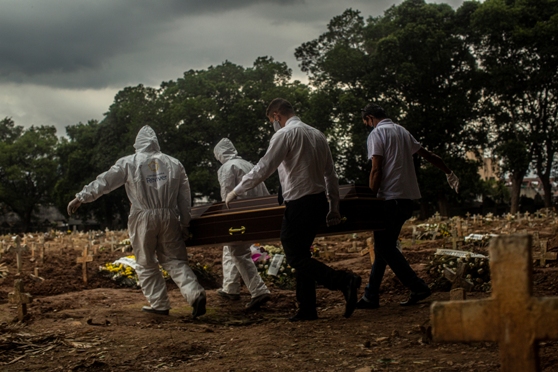Coronavirus deaths pass 1 million worldwide

By Richard Pérez Peña
More than HIV. More than dysentery. More than malaria, influenza, cholera and measles — combined.
In the 10 months since a mysterious pneumonia began striking residents of Wuhan, China, COVID-19 has killed more than 1 million people worldwide as of Monday (28) — an agonizing toll compiled from official counts, yet one that far understates how many have really died. It may already have overtaken tuberculosis and hepatitis as the world’s deadliest infectious disease, and unlike all the other contenders, it is still growing fast.
Like nothing seen in more than century, the coronavirus has infiltrated every populated patch of the globe, sowing terror and poverty, infecting millions of people in some nations and paralyzing entire economies. But as attention focuses on the devastation caused by halting a large part of the world’s commercial, educational and social life, it is all too easy to lose sight of the most direct human cost.
More than 1 million people — parents, children, siblings, friends, neighbours, colleagues, teachers, classmates — all gone, suddenly, prematurely. Those who survive COVID-19 are laid low for weeks or even months before recovering, and many have lingering ill effects whose severity and duration remain unclear.
Yet much of the suffering could have been avoided — one of the most heartbreaking aspects of all.
“This is a very serious global event, and a lot of people were going to get sick and many of them were going to die, but it did not need to be nearly this bad,” said Tom Inglesby, the director of the Johns Hopkins Centre for Health Security, which aims to protect people’s health from epidemics and disasters.
Places like China, Germany, South Korea and New Zealand have shown that it is possible to slow the pandemic enough to limit infections and deaths while still reopening businesses and schools.
But that requires a combination of elements that may be beyond the reach of poorer countries and that even ones like the United States have not been able to muster: wide-scale testing, contact tracing, quarantining, social distancing, mask wearing, providing protective gear, developing a clear and consistent strategy, and being willing to shut things down in a hurry when trouble arises.
No one or two or three factors are the key. “It’s all an ecosystem. It all works together,” said Martha Nelson, a scientist at the National Institutes of Health who specializes in epidemics and viral genetics, and who studies COVID-19.
It comes down to resources, vigilance, political will and having almost everyone take the threat seriously — conditions harder to attain when the disease is politicized, when governments react slowly or inconsistently, and when each state or region goes its own way, advisable or not.
“It’s one thing to have all the technical capabilities, but if our leaders undermine science, minimize the epidemic or falsely reassure people, we put everything else at risk,” Inglesby said.
Time and again, experts say, governments reacted too slowly, waiting until their own countries or regions were under siege, either dismissing the threat or seeing it as China’s problem, or Asia’s, or Italy’s, or Europe’s, or New York’s.
Thomas R. Frieden, a former head of the US Centres for Disease Control and Prevention, said that a major failing had been in governments’ communication with the public, nowhere more so than in the United States.
“You have standard principles of risk communication: Be first, be right, be credible, be empathetic,” he said. “If you tried to violate those principles more than the Trump administration has, I don’t think you could.”
The world now knows how to bend the curve of the pandemic — not to eliminate risk, but to keep it to a manageable level — and there have been surprises along the way.
Masks turned out to be more helpful than Western experts had predicted. Social distancing on an unheard-of scale has been more feasible and effective than anticipated. The difference in danger between an outdoor gathering and an indoor one is greater than expected.
And, crucially, people are most contagious when they first show symptoms or even earlier, not days or weeks later, when they are sickest — a reversal of the usual pattern with infectious diseases. That makes preventive measures like wearing masks and swift responses like isolating and testing people for possible exposure much more important; if you wait until the problem is evident, you’ve waited too long.
Countries have learned the hard way that their supply chains for testing kits, laboratory chemicals and protective equipment were inadequate, too prone to breakdown, or too dependent on foreign suppliers.
It remains unclear how the virus mutates, or how fast, which makes it impossible to predict how long a possible vaccine might work. More broadly, the pandemic has exposed how little scientists know about coronaviruses, even those that cause the common cold, and especially those that circulate in bats and other animals.
“It seems to people who are on lockdown that it’s going on interminably, but for scientists it’s just the beginning,” Nelson said. “We are still just scratching the surface of this.”
From a public health standpoint, the biggest unknown may be whether the world will be any better prepared when — not if, but when — the next pandemic arrives.
-New York Times

